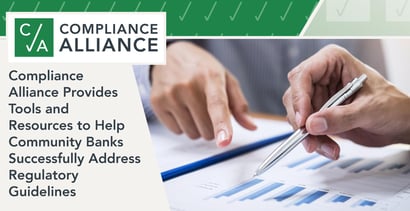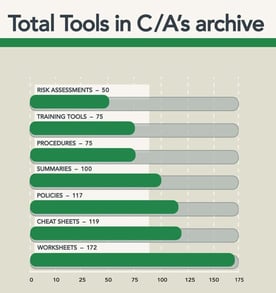

In a Nutshell: Congress passed the Dodd-Frank Act in 2010 to protect consumers and increase transparency in the financial industry. The Texas Bankers Association saw a need to provide tools and information to its community bank members to assist them in complying with the new legislation. Other state banking associations noticed the positive results and joined to form the Compliance Alliance, which works with more than 600 banks in 49 states. In a shifting regulatory environment, Compliance Alliance serves as a vital resource for banks of all sizes that need support to manage their responsibilities to safeguard consumers.
No matter who’s in charge of government at the federal or state level, regulations are a fact of life for banks. But while the biggest banks have their own compliance departments, smaller institutions must make do with fewer internal resources — and accomplish the same goals.
After Congress passed the Dodd-Frank Act in 2010 to help protect consumers, the regulatory burden on banks grew. The situation got to the point where the Texas Bankers Association (TBA) decided it needed to do something to help its smaller member banks. So TBA’s CEO asked staff legal officer Scott Daugherty to step in.
“Our banks were in a quandary,” Daugherty said. “We got about 15 compliance officers around Texas together and asked them what we could do to help. They gave us a long list of things — most of which we couldn’t do at the time.”

That led TBA to create Compliance Alliance to fill the role of compliance outsource partner for Texas banks — with Daugherty as its leader. “I hired a couple of people, and we started creating tools,” he said. “We started with 10 banks and quickly grew up to 35 or 40 within a month or two.”
Soon, other state banking associations asked to participate, and Compliance Alliance began to grow. Now Daugherty is President and General Counsel of Bankers Alliance, the company that operates Compliance Alliance, which offers services to more than 600 FDIC-insured banks in 49 states.
“We offer tools and resources to help banks save time and money when it comes to compliance,” Daugherty said. “We started in 2011 with no tools — now we’ve got more than 1,700 tools available for banks to download.”
Online Compliance Resources Help Banks of All Sizes
State associations with an ownership stake in Compliance Alliance stand to benefit when the company generates a profit. But banks operating in non-ownership states receive the same access to Compliance Alliance resources. And the service is appropriate for institutions of all sizes.

Compliance Alliance offers more than 1,700 tools to help banks manage regulations.
“People ask us, ‘What size banks do you work with?’ and we answer that we’ll work with any bank,” Daugherty said. “Our smallest has about $25 million in assets while our largest has about $35 billion — so it’s a pretty broad range.” About 80-85% of Compliance Alliance’s customers are community institutions with under $500 million in assets.
They all receive full access to Compliance Alliance in return for a flat fee. The site’s library of tools, forms, and checklists is meticulously organized by banking function and by tool type. Users may also select tools appropriate for addressing specific laws and regulations or survey toolkits relating to certain areas of compliance.
Even when the flurry of new regulations seems to slow, banks can revise policies and procedures, execute reporting responsibilities, train staff — and seamlessly address customer issues. Bank personnel can also contact the company through the Compliance Alliance All-Access Hotline via phone, email, or live chat.
“Anyone at our member banks can pick up the phone and ask questions,” Daugherty said. “When a staff member is talking to a bank customer, and they’re trying to open a checking account but aren’t sure of the documentation, they can simply hit the chat button and ask the question, and it makes it seamless for the customer. Last year we answered over 52,000 questions for our members.”
And chats have an average wait time of less than 30 seconds.
“We know when bankers send us a chat it is often time-sensitive and they may have a customer in front of them so we want to make sure they get immediate assistance and answers to their questions. Getting an answer in two hours or the next day does the bank no good. We get that,” Daugherty said.
Summaries and Updates on New Regulations Keep Institutions Informed
Compliance Alliance also does the legwork associated with translating the complex legal and regulatory language into practical terms. When a new regulation appears, Compliance Alliance first prepares a summary. Then it writes appropriate and customizable policies and procedures in many mediums — sometimes incorporating checklists and flowcharts — and follows with presentations for training purposes.
“Think of a 1,000-page regulation and trying to read it and make sense of it — that’s the first hurdle compliance officers have,” Daugherty said. “We give them everything from a summary of the regulation and what they need to do — an action plan — to a tool to train their staff.”
Other training resources include informative webinars.
“We do at least two webinars every month,” Daugherty said. “Those run the gamut — it could be a current thing we see going on, and a lot is driven by questions that we get.”
Periodic communications pieces include an ad-free monthly magazine presenting long-form articles on current compliance issues along with macro-level content aimed at senior management. A weekly newsletter keeps frontline compliance personnel in the loop with timely, practical tips. Members can also sign up to receive daily emails containing news and updates pulled from a wide range of news agencies and federal websites.
Compliance Alliance also produces short training videos on consumer and banking-regulation topics called Compliance Minutes.
“Those are usually one- to two-minute videos that hit the high levels of an area,” Daugherty said.
Compliance Alliance: A Regulatory Partner Dedicated to the Success of Community Banks
At the height of the transition to the Dodd-Frank framework, compliance officers faced between 50 and 75 new federal regulations every year. Compliance Alliance was founded to ease the burden on banks of implementing new policies and procedures during the transition.
“On top of that, banks have a whole litany of regulations they need to comply with daily — and ensure they’re doing them properly,” Daugherty said. “So a compliance officer’s day’s going to start early. They’re going to go in and try to get some things done and maybe knock out some training for the staff before the lobby opens — and then they’re going to get questions all day long.”

Scott Daugherty is the President and General Counsel of Bankers Alliance — Compliance Alliance’s parent company.
What’s more, bank boards and senior managers generally expect procedures to undergo an annual review. According to Daugherty, the average bank has about 60 different policies.
Consequently, Compliance Alliance makes a document review service available to its members. The service helps institutions review policies, procedures, disclosures, new products info, and even advertising and marketing copy for consistency and adherence to standards.
“We’ll tell them if there’s anything that needs to be updated if there’s anything that’s not accurate,” Daugherty said.
And Compliance Alliance continues to respond to the needs of its member institutions. Regulations may ebb and flow, but they never go away, and feedback from banks and state-association owners drives resource development on the site.
“We listen and get feedback a few different ways,” Daugherty said. “Sometimes, a bank will send in a chat looking for a tool or feature. And if we don’t have it, we’ll create it. More than half of our tools were created in response to member requests. We’ll put our heads together and come up with a way.”
Advertiser Disclosure
BadCredit.org is a free online resource that offers valuable content and comparison services to users. To keep this resource 100% free for users, we receive advertising compensation from the financial products listed on this page. Along with key review factors, this compensation may impact how and where products appear on the page (including, for example, the order in which they appear). BadCredit.org does not include listings for all financial products.
Our Editorial Review Policy
Our site is committed to publishing independent, accurate content guided by strict editorial guidelines. Before articles and reviews are published on our site, they undergo a thorough review process performed by a team of independent editors and subject-matter experts to ensure the content’s accuracy, timeliness, and impartiality. Our editorial team is separate and independent of our site’s advertisers, and the opinions they express on our site are their own. To read more about our team members and their editorial backgrounds, please visit our site’s About page.
